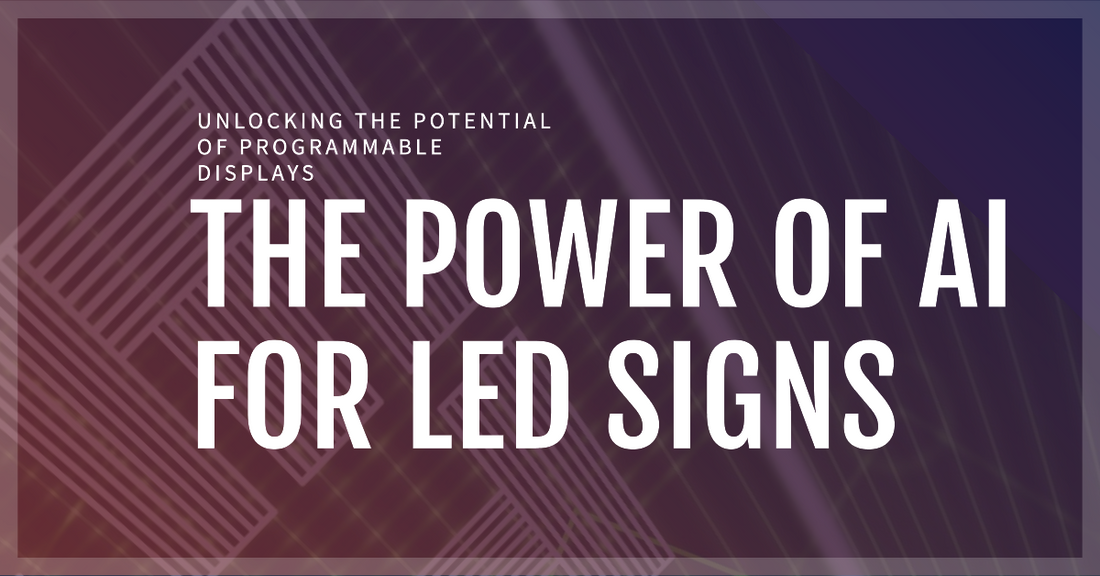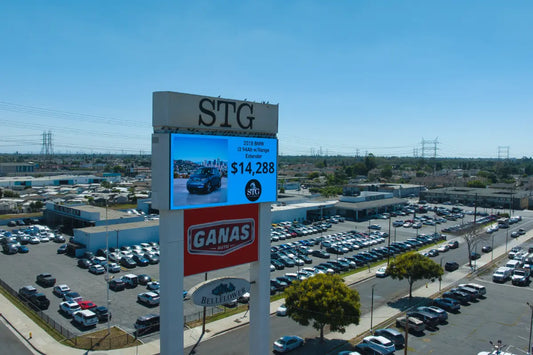
The Power of AI for LED Signs
With AI leading technological advancements, the field of digital signage is experiencing a revolutionary change. Businesses will one day be able to deploy AI-powered programmable LED signs, offering an array of advantages from personalized marketing to real-time audience interaction. The growing Artificial Intelligence market, projected to hit $1,811.75 Billion by 2030, reflects AI's expansive impact.
The Types of AI Technologies in Digital Signboards
Recommendation Systems
Recommendation systems utilize AI to analyze user behavior, preferences, and past interactions to offer personalized content suggestions. These systems can dramatically increase conversion rates by targeting customers with relevant products and offers at the right time.
Sentiment Analysis
Sentiment Analysis allows signboards to understand and respond to customer emotions and opinions. This can enable a business to react quickly to consumer feedback, aligning marketing messages with public sentiment and increasing brand trust.
Natural Language Processing (NLP)
NLP enhances user engagement by processing and understanding spoken language. It can enable digital signboards to participate in customer service, answering questions or guiding viewers to specific products or services.
Gesture Recognition
Gesture Recognition facilitates an interactive customer experience by responding to hand movements and physical gestures. This technology can transform the way customers browse and shop, making digital interfaces more intuitive and engaging.
Deep Learning
Deep Learning algorithms process complex patterns and data. They can enable digital signboards to create dynamic and creative advertising content, recognizing emerging trends and adapting messages accordingly.
Machine Learning
Machine Learning algorithms provide the ability to analyze customer behavior over time, predicting future behaviors and trends. This predictive analysis can lead to more effective targeting and a more cohesive marketing strategy.
Computer Vision
Computer Vision empowers digital signboards to detect and interpret visual data. It has applications in security and crowd management, allowing signboards to recognize VIP customers or alert staff to potential shoplifting or other security concerns.
How AI Transforms Digital Signboards
Personalized Content
By analyzing user data, AI can create content that resonates with individual viewers, enhancing their connection to the brand.
Real-time Adaptation
AI technologies allow signboards to adapt content in real-time based on various factors such as current events, weather, or stock availability.
Interactive Experiences
With voice and gesture recognition, AI-powered signboards can create a more immersive and engaging shopping experience.
Data-Driven Insights
AI provides insights based on collected data, aiding advertisers and content creators in making informed decisions for more effective campaigns.
Efficient Operation
Remote control and AI-driven content generation minimize manual effort, ensuring that the signboard always displays relevant and engaging information.
Conclusion
From small businesses to multinational corporations, programmable LED signs with AI technologies offer unparalleled opportunities for targeted and effective advertising. As Hollywood writers have been on strike for over 100 days, fearing an AI takeover, the advertising industry is embracing AI's potential. By incorporating various AI technologies, businesses can create a more engaging, personalized, and responsive advertising strategy, forging stronger connections with customers and driving growth. It's time to explore the future of advertising with programmable LED signs.
FAQ
-
What are AI-powered programmable LED signs? AI-powered programmable LED signs are digital displays that use Artificial Intelligence technologies to offer personalized marketing, real-time audience interaction, and various other advanced features.
-
How is AI transforming digital advertising? AI is revolutionizing digital advertising by enabling personalized content, real-time adaptation, interactive experiences, data-driven insights, and efficient operation of digital signboards.
-
What types of AI technologies are used in digital signboards? Digital signboards utilize AI technologies such as Recommendation Systems, Sentiment Analysis, Natural Language Processing, Gesture Recognition, Deep Learning, Machine Learning, and Computer Vision.
-
How does AI enable personalized content in digital advertising? AI analyzes user data to create content that resonates with individual viewers, enhancing their connection to the brand and increasing conversion rates.
-
What are the applications of Computer Vision in digital signboards? Computer Vision in digital signboards detects and interprets visual data, with applications in security and crowd management, such as recognizing VIP customers or alerting staff to potential security concerns.
-
How do Gesture Recognition and Voice Recognition enhance customer experience? Gesture and Voice Recognition technologies make digital interfaces more intuitive and engaging by responding to hand movements, physical gestures, and spoken language.
-
What is the projected market value of Artificial Intelligence by 2030? The Artificial Intelligence market is projected to hit $1,811.75 Billion by 2030, reflecting its expansive impact across various industries, including digital advertising.
-
How do AI-powered LED signs contribute to efficient operation? AI-powered LED signs enable remote control and AI-driven content generation, minimizing manual effort and ensuring the display of relevant and engaging information.
-
Can AI-powered LED signs adapt content in real-time? Yes, AI technologies allow digital signboards to adapt content in real-time based on factors such as current events, weather, or stock availability, making advertising more responsive.
-
Why are businesses embracing AI in programmable LED signs? Businesses are embracing AI in programmable LED signs to create more engaging, personalized, and responsive advertising strategies, forging stronger connections with customers and driving growth.





